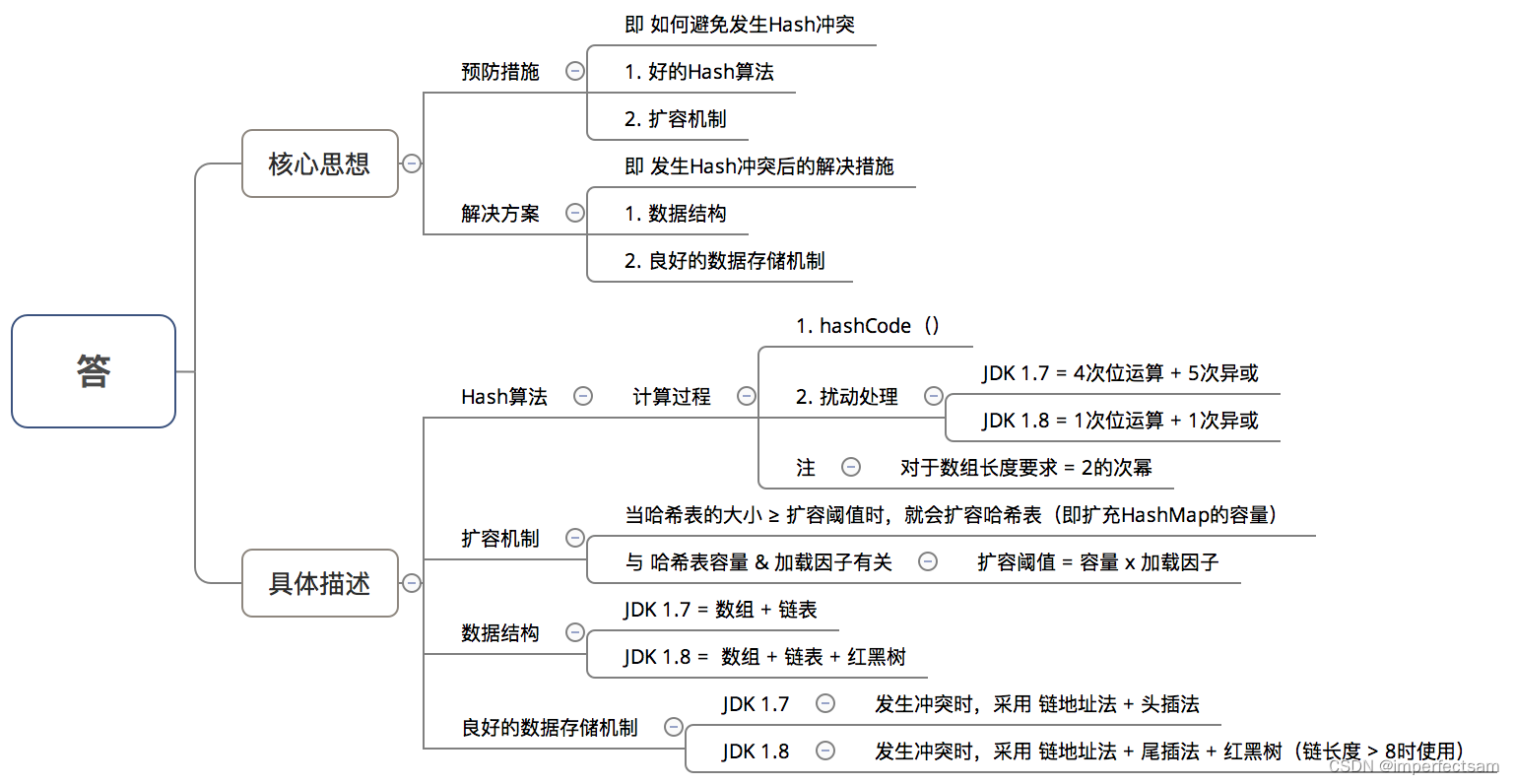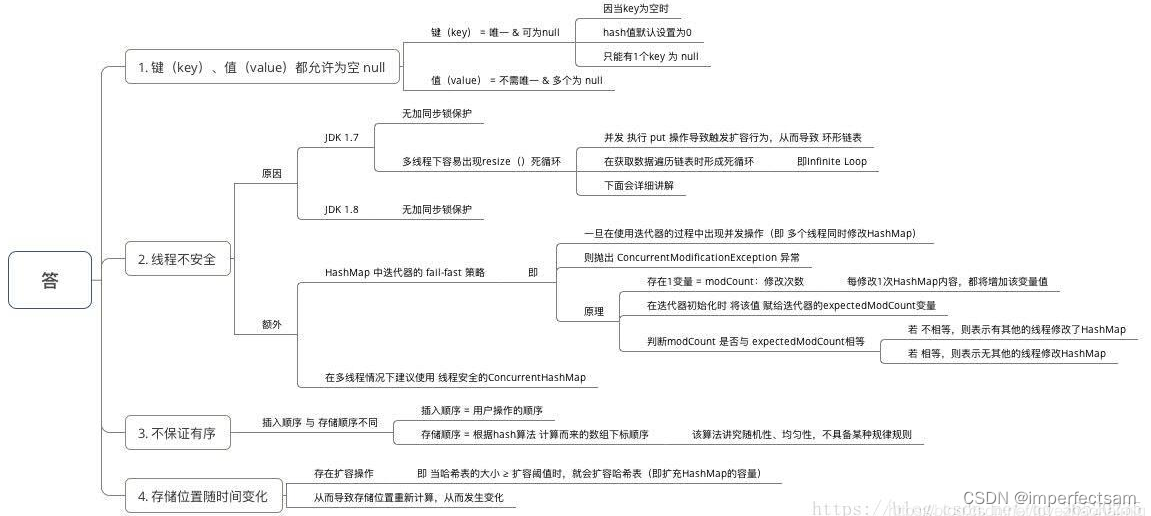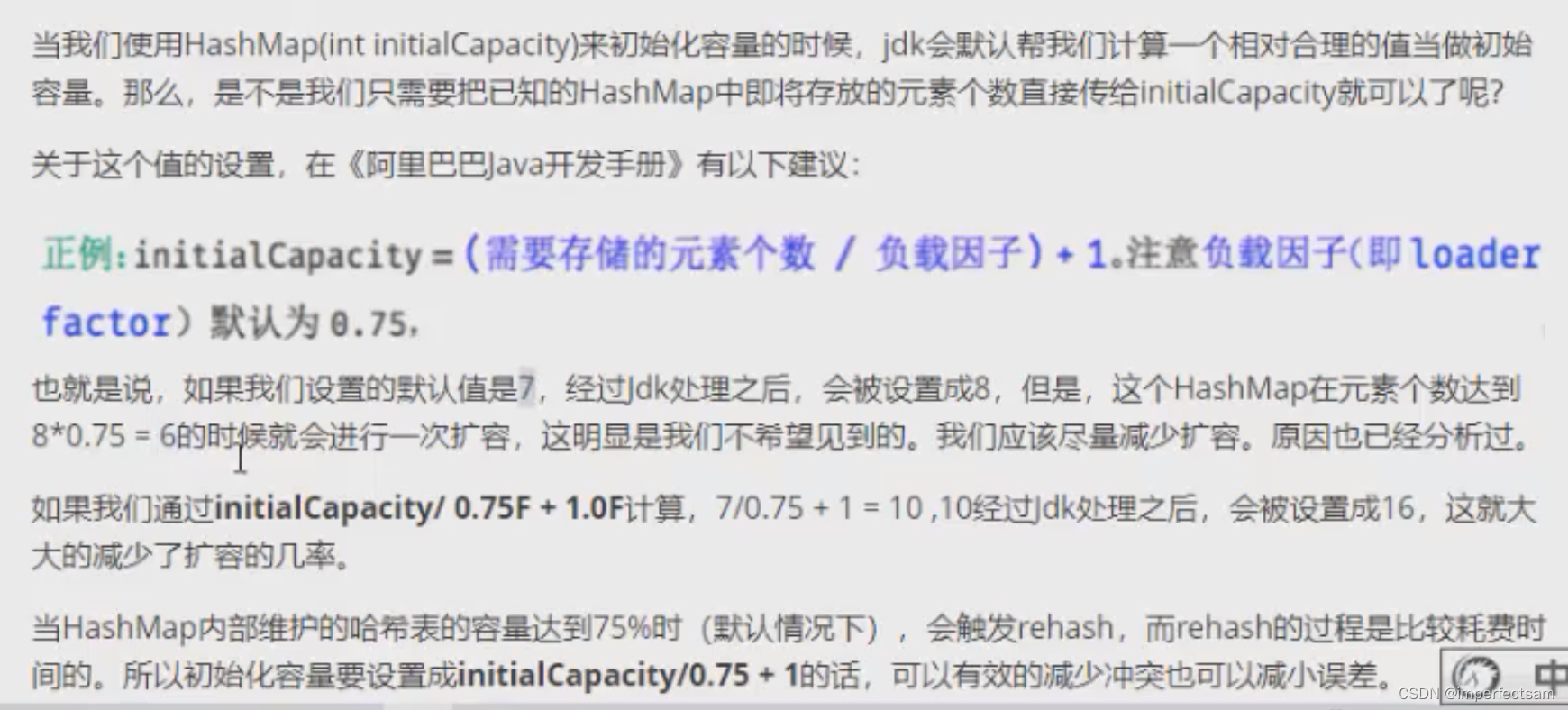HashMap是Java中实现了Map接口的一种数据结构,它提供了一种存储键值对的方式。HashMap基于哈希表实现,具有快速的查找性能,平均情况下,插入、删除和获取元素的时间复杂度都是O(1)。
以下是HashMap的主要特点和使用方法:
1、键值对存储:HashMap存储的是键值对(key-value pair),每个键都是唯一的,而值可以重复。通过键来获取值,可以快速查找、插入和删除元素。
2、哈希表实现:HashMap内部使用了一个数组来存储元素,每个元素是一个链表或红黑树的头节点。在插入元素时,通过对键进行哈希计算,确定元素在数组中的位置,然后将元素插入到对应位置的链表或树中。
3、键的唯一性:在HashMap中,每个键都必须是唯一的。如果添加了重复的键,则新的值将覆盖旧的值。但是,值可以是重复的。
4、非线程安全:HashMap不是线程安全的,如果多个线程同时访问和修改HashMap,可能会导致数据不一致的问题。如果需要在多线程环境中使用,可以考虑使用ConcurrentHashMap或通过同步手段来保证线程安全。
5、迭代顺序不固定:HashMap的迭代顺序不是固定的,取决于元素的哈希码及其在数组中的位置。因此,不要依赖于迭代顺序。
6、容量和负载因子:HashMap有两个重要的参数:初始容量和负载因子。初始容量是哈希表中桶的数量,默认为16;负载因子是哈希表在容量自动增加之前可以达到多满的一个度量,默认为0.75。当哈希表的大小超过负载因子与当前容量的乘积时,将会重新调整大小。
我们先来看一下HashMap的属性常量
/**
* The default initial capacity - MUST be a power of two.
*/
static final int DEFAULT_INITIAL_CAPACITY = 1 << 4; // aka 16
/**
* The maximum capacity, used if a higher value is implicitly specified
* by either of the constructors with arguments.
* MUST be a power of two <= 1<<30.
* 最大容量,为什么int的最大值2^31-1呢?和扩容机制有关,保证容量为2的幂
*/
static final int MAXIMUM_CAPACITY = 1 << 30;
/**
* The load factor used when none specified in constructor.
* 默认扩容负载因子
*/
static final float DEFAULT_LOAD_FACTOR = 0.75f;
/**
* The bin count threshold for using a tree rather than list for a
* bin. Bins are converted to trees when adding an element to a
* bin with at least this many nodes. The value must be greater
* than 2 and should be at least 8 to mesh with assumptions in
* tree removal about conversion back to plain bins upon
* shrinkage.
* 树化阈值
*/
static final int TREEIFY_THRESHOLD = 8;
/**
* The bin count threshold for untreeifying a (split) bin during a
* resize operation. Should be less than TREEIFY_THRESHOLD, and at
* most 6 to mesh with shrinkage detection under removal.
* 链化阈值
*/
static final int UNTREEIFY_THRESHOLD = 6;
/**
* The smallest table capacity for which bins may be treeified.
* (Otherwise the table is resized if too many nodes in a bin.)
* Should be at least 4 * TREEIFY_THRESHOLD to avoid conflicts
* between resizing and treeification thresholds.
* TREEIFY_THRESHOLD达到8也不一定树化,必须保证总容量达到64
*/
static final int MIN_TREEIFY_CAPACITY = 64;
实例属性
/**
* 哈希表,懒初始化(在第一次存入元素的时候),自动调整大小,长度为2的倍数
*/
transient Node<K,V>[] table;
/**
* Holds cached entrySet(). Note that AbstractMap fields are used
* for keySet() and values().
*/
transient Set<Map.Entry<K,V>> entrySet;
/**
* 元素个数
*/
transient int size;
/**
* 迭代时的并发修改次数
*/
transient int modCount;
/**
* 当前容量与负载因子的乘积,表示下次扩容的元素个数阈值
*/
// (The javadoc description is true upon serialization.
// Additionally, if the table array has not been allocated, this
// field holds the initial array capacity, or zero signifying
// DEFAULT_INITIAL_CAPACITY.)
int threshold;
/**
* 负载因子,默认0.75
* @serial
*/
final float loadFactor;
构造函数
public HashMap() {
this.loadFactor = DEFAULT_LOAD_FACTOR; // all other fields defaulted
}
public HashMap(int initialCapacity) {
this(initialCapacity, DEFAULT_LOAD_FACTOR);
}
public HashMap(int initialCapacity, float loadFactor) {
if (initialCapacity < 0)
throw new IllegalArgumentException("Illegal initial capacity: " +
initialCapacity);
if (initialCapacity > MAXIMUM_CAPACITY)
initialCapacity = MAXIMUM_CAPACITY;
if (loadFactor <= 0 || Float.isNaN(loadFactor))
throw new IllegalArgumentException("Illegal load factor: " +
loadFactor);
this.loadFactor = loadFactor;
this.threshold = tableSizeFor(initialCapacity);
}
public HashMap(Map<? extends K, ? extends V> m) {
this.loadFactor = DEFAULT_LOAD_FACTOR;
putMapEntries(m, false);
}
public V put(K key,V value)
public V put(K key, V value) {
return putVal(hash(key), key, value, false, true);
}
首先会根据key获取hash值:
HashMap仅允许一个元素的键为null,其hash用0代替
获取key的hashCode值,高16位和低16位与运算,获得16位的有效数值。
static final int hash(Object key) {
int h;
return (key == null) ? 0 : (h = key.hashCode()) ^ (h >>> 16);
}
final V putVal(int hash, K key, V value, boolean onlyIfAbsent,boolean evict)
真正存入元素的方法:
/**
* Implements Map.put and related methods
*
* @param hash hash for key
* @param key the key
* @param value the value to put
* @param onlyIfAbsent if true, don't change existing value
* @param evict if false, the table is in creation mode.
* @return previous value, or null if none
*/
final V putVal(int hash, K key, V value, boolean onlyIfAbsent,
boolean evict) {
Node<K,V>[] tab; Node<K,V> p; int n, i;
// 判断hash表是否为空
if ((tab = table) == null || (n = tab.length) == 0)
// 初始化hash表或重新构建
n = (tab = resize()).length;
// 根据key的hash计算所在桶的索引
// p为该桶的头结点
if ((p = tab[i = (n - 1) & hash]) == null)
// 该桶为空,直接放入桶数组位置
tab[i] = newNode(hash, key, value, null);
// 桶不为空
else {
Node<K,V> e; K k;
if (p.hash == hash &&
((k = p.key) == key || (key != null && key.equals(k))))
// 存入key与头结点key相同,覆盖
e = p;
else if (p instanceof TreeNode)
// 头结点是树根,则按照树的形式存入元素
e = ((TreeNode<K,V>)p).putTreeVal(this, tab, hash, key, value);
else {
// 正常链表
for (int binCount = 0; ; ++binCount) {
if ((e = p.next) == null) {
// 找到链尾结点
// 通过存入键值对构建新节点,并作为链尾节点
p.next = newNode(hash, key, value, null);
// 判断链表长度,此时binCount为7,则链长为8
if (binCount >= TREEIFY_THRESHOLD - 1) // -1 for 1st
// 将链表树化
treeifyBin(tab, hash);
break;
}
if (e.hash == hash &&
((k = e.key) == key || (key != null && key.equals(k))))
// 存入key与该结点key相同,覆盖
break;
// 指针移动到下一个链节点
p = e;
}
}
// e不为null,表示存入的key已经在
if (e != null) { // existing mapping for key
V oldValue = e.value;
// 会覆盖值
if (!onlyIfAbsent || oldValue == null)
e.value = value;
afterNodeAccess(e);
// 返回旧值
return oldValue;
}
}
++modCount;
// 更新元素个数,重哈希
if (++size > threshold)
resize();
afterNodeInsertion(evict);
return null;
}
resize()
初始化哈希表或按照旧表容量的2倍扩容并重新分配元素。
/**
* Initializes or doubles table size. If null, allocates in
* accord with initial capacity target held in field threshold.
* Otherwise, because we are using power-of-two expansion, the
* elements from each bin must either stay at same index, or move
* with a power of two offset in the new table.
*
* @return the table
*/
final Node<K,V>[] resize() {
Node<K,V>[] oldTab = table;
// 旧的哈希表长度
int oldCap = (oldTab == null) ? 0 : oldTab.length;
// 扩容阈值,默认为0
int oldThr = threshold;
int newCap, newThr = 0;
if (oldCap > 0) {
if (oldCap >= MAXIMUM_CAPACITY) {
// hash数组的达到上限
threshold = Integer.MAX_VALUE;
return oldTab;
}
// 新哈希表容量2倍
else if ((newCap = oldCap << 1) < MAXIMUM_CAPACITY &&
oldCap >= DEFAULT_INITIAL_CAPACITY)
// 扩容阈值也2倍
newThr = oldThr << 1; // double threshold
}
// 通过构造指定了初始容量
else if (oldThr > 0) // initial capacity was placed in threshold
newCap = oldThr;
else { // zero initial threshold signifies using defaults
// 16
newCap = DEFAULT_INITIAL_CAPACITY;
// 12
newThr = (int)(DEFAULT_LOAD_FACTOR * DEFAULT_INITIAL_CAPACITY);
}
if (newThr == 0) {
float ft = (float)newCap * loadFactor;
newThr = (newCap < MAXIMUM_CAPACITY && ft < (float)MAXIMUM_CAPACITY ?
(int)ft : Integer.MAX_VALUE);
}
threshold = newThr;
@SuppressWarnings({"rawtypes","unchecked"})
// 根据容量初始化一个新哈希表
Node<K,V>[] newTab = (Node<K,V>[])new Node[newCap];
table = newTab;
if (oldTab != null) {
// 以下是扩容操作
// 遍历哈希表所有的桶
for (int j = 0; j < oldCap; ++j) {
Node<K,V> e;
if ((e = oldTab[j]) != null) {
oldTab[j] = null;
if (e.next == null)
// 旧桶中的头结点,但是没有后续节点
// 直接重新哈希放入新哈希表中
newTab[e.hash & (newCap - 1)] = e;
else if (e instanceof TreeNode)
// 头结点为树的根结点,将这棵树的节点重新分配到其他桶中
((TreeNode<K,V>)e).split(this, newTab, j, oldCap);
else { // preserve order
// 链表
Node<K,V> loHead = null, loTail = null;
Node<K,V> hiHead = null, hiTail = null;
Node<K,V> next;
do {
next = e.next;
// 下面单独分析
if ((e.hash & oldCap) == 0) {
if (loTail == null)
loHead = e;
else
loTail.next = e;
loTail = e;
}
else {
if (hiTail == null)
hiHead = e;
else
hiTail.next = e;
hiTail = e;
}
} while ((e = next) != null);
if (loTail != null) {
loTail.next = null;
newTab[j] = loHead;
}
if (hiTail != null) {
hiTail.next = null;
newTab[j + oldCap] = hiHead;
}
}
}
}
}
return newTab;
}
这里需要注意的就是hashMap在进行扩容的时候,并不是真正地去重新计算hashCode。而是通过以下这种方式去进行计算。
(e.hash & oldCap) == 0?
将重新分配的元素key hash值和旧哈希表容量相与是什么意思呢?
假设oldCap为16,则newCap=32:
newCap(b)-1 = 11111
oldCap(b) = 10000
node1.hash = 1010010
node2.hash = 1000010
相当于两个hash的第五位和oldCap的第五位相与,node1为1,node2为0。
相与为0,则在新表中桶索引不变,00010
相与为1,则在新表中索引是10010,相比在旧表中的桶索引左移一位,增加16
public V get(Object key)
public V get(Object key) {
Node<K,V> e;
return (e = getNode(hash(key), key)) == null ? null : e.value;
}
final Node<K,V> getNode(int hash, Object key)
/**
* Implements Map.get and related methods
*
* @param hash hash for key
* @param key the key
* @return the node, or null if none
*/
final Node<K,V> getNode(int hash, Object key) {
Node<K,V>[] tab; Node<K,V> first, e; int n; K k;
// 根据key的hash值获取桶索引
if ((tab = table) != null && (n = tab.length) > 0 &&
(first = tab[(n - 1) & hash]) != null) {
if (first.hash == hash && // always check first node
((k = first.key) == key || (key != null && key.equals(k))))
// 真巧,目标元素就是桶的头结点
return first;
if ((e = first.next) != null) {
// 如果这个桶是树结构,则要专门通过树的方式获取节点
if (first instanceof TreeNode)
return ((TreeNode<K,V>)first).getTreeNode(hash, key);
// 链表结构,循环遍历匹配key就行了
do {
if (e.hash == hash &&
((k = e.key) == key || (key != null && key.equals(k))))
return e;
} while ((e = e.next) != null);
}
}
return null;
}
treeifyBin尝试把链表转换为红黑树
final void treeifyBin(Node<K,V>[] tab, int hash) {
int n, index; Node<K,V> e;
//这里会进行一次判断,当整个table中的元素小于MIN_TREEIFY_CAPACITY的时候我们会去进行扩容,而不是转
//换为红黑树,而这里的MIN_TREEIFY_CAPACITY的大小默认是为64
if (tab == null || (n = tab.length) < MIN_TREEIFY_CAPACITY)
resize();
else if ((e = tab[index = (n - 1) & hash]) != null) {
TreeNode<K,V> hd = null, tl = null;
do {
TreeNode<K,V> p = replacementTreeNode(e, null);
if (tl == null)
hd = p;
else {
p.prev = tl;
tl.next = p;
}
tl = p;
} while ((e = e.next) != null);
if ((tab[index] = hd) != null)
hd.treeify(tab);
}
}
| JDK1.7 | JDK1.8 | |
|---|---|---|
| 数据结构 | 数组+链表 | 数组+链表+红黑树 |
| 插入方法 | 头插法。存在循环链表 | 尾插法。因为采用尾插法,解决了循环链表问题 |
| 扩容机制 | hash&需要扩容的二进制数,所以扩容必须是2的幂 | 扩容前所在桶索引&扩容后的容量0:当前桶1:扩容前所在桶索引+扩容后的容量(相当于所在桶索引变为之前的2倍) |
| 线程安全问题 | 因为采用头插法,存在环形链表的问题 | 元素并发插入到同一位置,造成数据覆盖 |
Q&A:哈希表如何解决冲突?

Q&A为什么HashMap键值都允许为空、线程不安全、不保证有序、存储位置会变化?

Q&A为什么HashMap中String、Integer这样的包装类适合作为key?

Q&AHashMap中为什么使用红黑树而不是使用AVL(自平衡二叉查找树)树?
1、平衡性能好:
红黑树是一种自平衡的二叉搜索树,保持了较好的平衡性能。AVL树虽然也是自平衡的,但它需要维护更为严格的平衡条件,因此在插入和删除操作时需要更多的旋转操作,而红黑树的旋转操作相对较少,性能更高。
2、复杂度较低
红黑树的插入、删除和查找操作的时间复杂度均为O(log n),而AVL树的时间复杂度也是O(log n),但由于它的平衡条件更严格,因此需要更多的旋转操作,可能会导致性能略低。
3、实现简单
相比于AVL树,红黑树的实现较为简单,代码量较少,容易理解和维护。
HashMap中容量的初始化






















 845
845











 被折叠的 条评论
为什么被折叠?
被折叠的 条评论
为什么被折叠?








